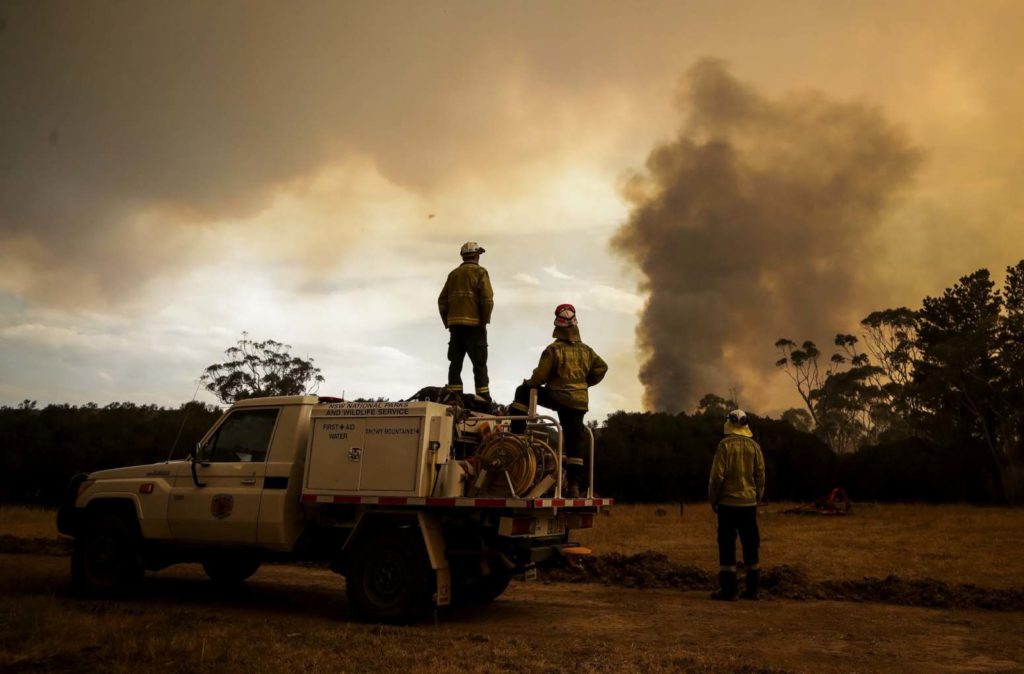
By Tim Barlass – 9th December 2019
Click HERE or the logo (above) to view the original news article.
A forestry expert has condemned bushfire prevention strategies in an open letter to the Prime Minister and premiers, saying it is entirely within their power to put an end to the situation by prescribed burning.
Vic Jurskis, a fellow of the Institute of Foresters of Australia, the body representing more than 1200 forestry professionals, says Australians are being told that “fires are uncontrollable in extreme weather and there’s nothing we can possibly do”.

He said the “simple solution” of preventative or prescribed burns to reduce fuel levels of leaves, dead twigs and other vegetation emerged from a House of Representatives inquiry after the 2003 Canberra fires, which destroyed 488 houses.
Mr Jurskis said: “The fires that burnt Canberra in 2003 jumped over miles and miles of bare paddocks. The problem is if you have three-dimensional, continuous fuel and extreme conditions, you can generate ember showers that travel tens of kilometres ahead of the front.
“A fire break is going to do nothing at all. You have to manage the whole landscape.”

Fire captain Brian Williams, 73, vice-president of the Volunteer Fire Fighters Association, supports the prescribed burn argument. He spoke after a 12-hour night shift fighting the Three Mile fire burning north-east of Wiseman’s Ferry.
Mr Williams said: “The hazard-approval process is what is stuffing the whole process.
“It is bogged down by green [environmental] and red tape which makes getting approval for a prescribed burn a very slow and complex process.
“They have introduced a system that makes it virtually impossible to manage the bush in a sustainable way. I am just one of thousands of volunteers out there who are frustrated.”

David Packham, a former bushfire researcher at CSIRO, said fuel levels were at their highest since European settlement.
A spokesman for the RFS said it continued to take advantage of all opportunities to undertake hazard reduction activities but the biggest impediment for burning remained the weather.
“Longer fire seasons in south-east Australia have reduced the opportunities for fuel reduction burning,” the spokesman said.
“It’s important to note that a number of fires this season have burnt through areas that were hazard-reduced as little as two and three years ago. Therefore, hazard-reduction burning cannot be seen as the panacea.
“Hazard reduction is not just about burning and can include hand clearing or mechanical works such as mowing or slashing.
“In NSW, we have a strategic approach to hazard-reduction burning as part of an overall package of measures including controls on development in bushfire-prone areas, responding to hazard complaints and engaging with at-risk communities.”
Vic Jurskis
Vic Jurskis was born in Cooma in 1955. He lived his first few years at Eaglehawk Neck, in the construction camp for what is now known as Eucumbene Dam. He gained a Degree as Bachelor of Science (Forestry) from ANU and was awarded the (British) Commonwealth Forestry Book Prize for academic achievement.
After graduation, Vic worked for NSW Forestry Commission as a laborer in forestry camps at Jenolan and Sunny Corner before being appointed as a professional forester in 1978. He worked in all types of native forests and woodlands at Casino, Murwillimbah, Urbenville and Cobar and was an active member of bushfire brigades, before being transferred to Eden as Officer in Charge of the Forestry Commission’s Regional Research Centre, where he led a program of ecological research. The Centre covered all research activities in coastal and highlands forests south of Sydney. From 1997 until 2002, he was employed as the Forestry Commission’s Regional Planning Manager at Eden, before being appointed as Silviculturist for the Commission’s Native Forest Division, responsible for forest management across the State.
In 2004, Vic was awarded a Fellowship by the Joseph William Gottstein Memorial Trust, to investigate eucalypt decline across Australia. In 2006, he received an award from Australian Academy of Science, to extend these investigations more widely. He produced many reports and recommendations including a major review paper that has been widely cited in the international scientific literature. Vic has published many other papers in scientific journals, presented papers as a representative of NSW Forestry Commission at several international conferences in Australia, New Zealand and Mexico, and co-authored papers to other international conferences. He has given independent evidence at three parliamentary inquiries into land and fire management. Since retiring from the Forestry Commission in 2012, Vic continues to publish scientific articles and present papers at international conferences.
His first book – Firestick Ecology was published in 2015 and received favorable reviews in two international scientific journals. There were no negative reviews because the academic purveyors of conventional wisdom prefer not to draw attention to Vic’s work. Vic is currently working on his second book – Siberia to Eden: a family world history. He is a member of the Institute of Foresters of Australia and the Royal Australian Historical Society. Vic has a passionate desire to reinstate pragmatic, scientific land management in Australia, combining traditional knowledge and modern science.
